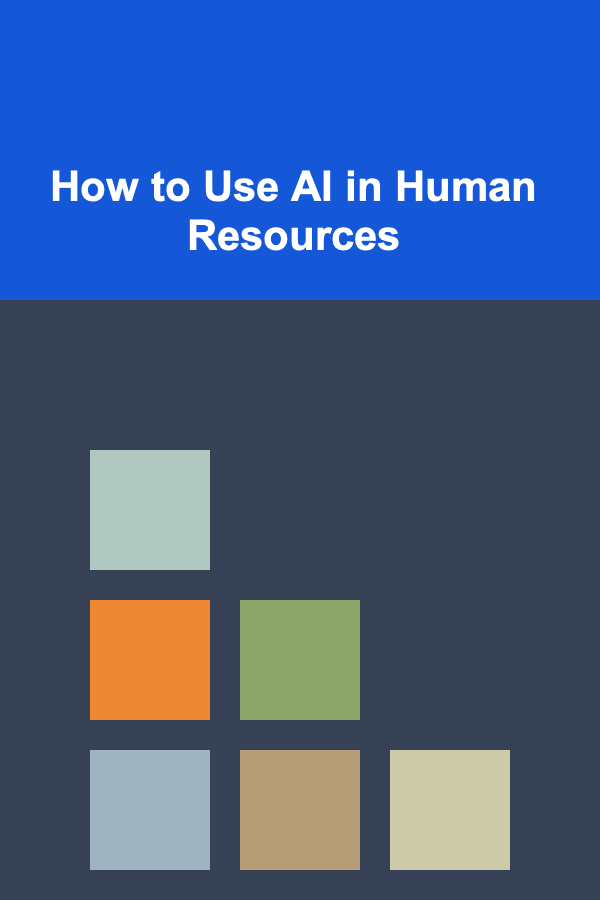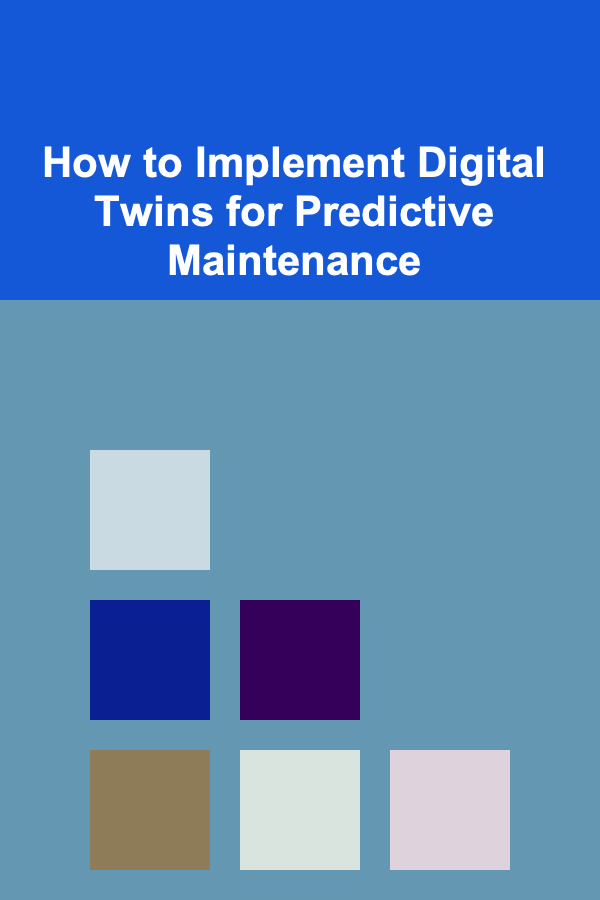
How to Use AI in Human Resources
ebook include PDF & Audio bundle (Micro Guide)
$12.99$5.99
Limited Time Offer! Order within the next:

Artificial Intelligence (AI) has become a cornerstone of modern technology, transforming various industries and functions. One of the areas that stand to benefit significantly from AI is Human Resources (HR). HR is traditionally a people-centric function, focusing on recruitment, employee management, training, and retention. However, with the integration of AI tools, HR can become more efficient, data-driven, and precise, allowing for improved decision-making and enhanced employee experiences.
In this article, we'll explore how AI can be leveraged in Human Resources, covering its applications, benefits, challenges, and the future of HR with AI integration.
The Role of AI in Human Resources
1. AI for Recruitment and Talent Acquisition
One of the most impactful uses of AI in HR is in the recruitment and talent acquisition process. Recruitment is a time-consuming and labor-intensive task that often involves reviewing hundreds or even thousands of resumes, interviewing candidates, and screening applicants. AI can streamline this process, ensuring that HR professionals spend less time on administrative tasks and more time on strategic decisions.
AI-Driven Resume Screening
Traditionally, recruiters manually sift through resumes, searching for keywords that match the job description. This process can be incredibly time-consuming and prone to human error. AI-based tools can scan and analyze resumes quickly, identifying key skills, experiences, and qualifications that match the job requirements. These tools use natural language processing (NLP) to understand context and nuance in resumes, helping HR professionals make more informed decisions faster.
Chatbots for Candidate Engagement
AI chatbots have also become an invaluable tool for engaging with candidates during the recruitment process. These chatbots can answer common questions, schedule interviews, provide feedback, and even conduct initial rounds of interviews. This automation improves the candidate experience, reduces HR's workload, and ensures a consistent, personalized communication flow.
Predictive Analytics for Talent Sourcing
AI can help HR professionals predict which candidates are most likely to succeed in a role based on historical data. By analyzing a large set of data from current and past employees, AI algorithms can identify patterns that correlate with high performance. This allows recruiters to focus on candidates who are more likely to be a cultural and functional fit for the organization, improving hiring accuracy and reducing turnover.
2. AI for Employee Engagement and Retention
AI is not just useful for recruitment; it can also play a crucial role in improving employee engagement and retention. Engaged employees are more likely to be productive, stay with the company long-term, and contribute positively to the work environment. AI tools can assist HR teams in creating personalized employee experiences that foster greater satisfaction and loyalty.
Sentiment Analysis and Feedback
AI-driven sentiment analysis tools allow HR departments to track employee morale and satisfaction in real-time. By analyzing feedback from surveys, emails, and other communication channels, AI algorithms can identify potential issues such as dissatisfaction, burnout, or disengagement. This early detection enables HR to intervene and address problems before they escalate, leading to better retention rates and a more positive work environment.
Personalized Learning and Development Plans
AI-powered systems can also be used to develop personalized learning and development (L&D) plans for employees. By analyzing individual performance data, learning preferences, and career goals, AI can suggest tailored training programs that align with an employee's specific needs. This personalized approach to professional development not only boosts engagement but also helps employees advance in their careers, making them feel valued by the organization.
AI-Driven Employee Wellness Programs
AI tools can be used to track employee wellness, helping to identify factors that may contribute to stress, burnout, or low engagement. For example, AI-powered applications can monitor workload levels, provide insights into work-life balance, and recommend wellness activities such as stress-relieving exercises or mindfulness practices. These interventions help create a healthier workplace, which in turn improves retention and reduces absenteeism.
3. AI for Performance Management
Effective performance management is crucial for organizational success, but it often involves subjective assessments and biased decision-making. AI can help mitigate bias, increase accuracy, and provide objective insights into employee performance.
Objective Performance Evaluations
AI can analyze employee performance data from multiple sources, such as project outcomes, peer reviews, and customer feedback. By aggregating this data, AI can offer objective, data-driven insights into an employee's strengths and areas for improvement. These evaluations are less likely to be influenced by bias, ensuring a more fair and transparent performance review process.
Continuous Feedback and Recognition
AI can facilitate continuous feedback loops, providing employees with regular, real-time feedback on their performance. This encourages ongoing learning and improvement, allowing employees to adjust their behaviors and performance before the formal review cycle. Additionally, AI can help HR teams recognize and reward high performers, boosting morale and encouraging further success.
AI in Goal Setting and Tracking
AI systems can also assist in setting and tracking employee goals. By analyzing individual progress and performance metrics, AI can suggest achievable goals and provide insights into how well employees are meeting them. This ensures that employees are aligned with organizational objectives, making it easier for HR to track progress and offer support when needed.
4. AI for Payroll and Benefits Management
AI can also play a significant role in automating payroll and benefits management, ensuring accuracy, efficiency, and compliance with relevant laws and regulations.
Automated Payroll Processing
AI-powered payroll systems can automatically calculate salaries, deductions, taxes, and benefits based on employee data, ensuring that payroll is processed accurately and on time. These systems can also be programmed to stay up-to-date with changes in tax laws, labor regulations, and employee benefits, reducing the administrative burden on HR teams and minimizing the risk of errors.
Benefits Optimization
AI can assist employees in selecting the best benefits packages by analyzing their preferences, family status, and health needs. By offering personalized recommendations, AI ensures that employees receive benefits that align with their specific circumstances. This not only enhances the employee experience but also helps organizations manage benefits costs more effectively.
5. AI for Diversity and Inclusion
Diversity and inclusion (D&I) are critical components of any modern organization. AI can assist HR in creating a more inclusive and diverse workforce by removing biases from the recruitment and promotion processes.
Bias Detection in Hiring
AI tools can be trained to detect and mitigate bias in job descriptions, resumes, and interview processes. For example, AI algorithms can identify gendered language in job postings that may discourage female candidates from applying. By ensuring that hiring processes are free from bias, AI helps HR teams build a more diverse and inclusive workforce.
Promoting Equal Opportunity
AI can also be used to track and promote equal opportunities within the workplace. By analyzing promotions, pay equity, and career progression data, AI can identify potential disparities that may exist between different demographic groups. This helps HR teams take proactive steps to ensure that all employees have equal opportunities for advancement, regardless of their background.
Benefits of Using AI in HR
1. Efficiency and Time Savings
AI can automate many routine and administrative tasks, such as resume screening, interview scheduling, and payroll processing. This frees up HR professionals to focus on more strategic tasks, such as employee development, engagement, and retention. As a result, HR teams can operate more efficiently and effectively.
2. Improved Decision Making
By leveraging data analytics and AI-driven insights, HR professionals can make more informed decisions. AI provides objective, data-driven recommendations that remove biases and subjectivity, leading to better hiring, performance evaluations, and employee development outcomes.
3. Enhanced Employee Experience
AI can personalize the employee experience by offering tailored development programs, benefits packages, and wellness interventions. This results in higher employee satisfaction, engagement, and retention.
4. Cost Savings
AI tools can help organizations reduce costs associated with recruitment, training, and administrative tasks. By automating these processes, HR departments can operate more efficiently, leading to significant cost savings in the long term.
Challenges of Implementing AI in HR
While AI offers numerous benefits, its implementation in HR is not without challenges. These challenges include:
1. Data Privacy and Security
HR departments handle sensitive employee data, and the use of AI in HR requires strict adherence to data privacy regulations. Organizations must ensure that AI tools are secure and that employee data is protected from unauthorized access.
2. Resistance to Change
Employees and HR professionals may resist adopting AI due to concerns about job displacement or a lack of understanding of how the technology works. It's important for organizations to provide training and education to ensure that AI is seen as a tool to enhance, rather than replace, human work.
3. Bias in AI Algorithms
AI algorithms are only as good as the data they are trained on. If the data is biased, the AI tool may perpetuate existing biases in hiring, performance evaluations, and other HR processes. Organizations must be vigilant in ensuring that their AI systems are trained on diverse and unbiased data to avoid reinforcing discrimination.
4. High Initial Investment
Implementing AI tools in HR requires a significant initial investment in technology and training. For smaller organizations, this upfront cost may be a barrier to adoption. However, the long-term benefits, including time savings and improved decision-making, often outweigh the initial expense.
The Future of AI in HR
The future of AI in HR is bright, with continued advancements in technology set to further transform the way HR functions. As AI tools become more sophisticated, they will offer even greater levels of automation, personalization, and insight. We can expect AI to play a pivotal role in creating more agile, data-driven HR departments that can better meet the needs of employees and organizations alike.
In the coming years, AI will likely take on a more strategic role in HR, assisting with workforce planning, organizational design, and change management. By integrating AI into every aspect of HR, organizations will be able to make better decisions, improve employee experiences, and drive business success.
Conclusion
AI is revolutionizing the field of Human Resources, offering significant benefits in recruitment, employee engagement, performance management, and more. By embracing AI technologies, HR departments can become more efficient, data-driven, and strategic, leading to improved employee satisfaction, retention, and organizational success. However, the implementation of AI must be done thoughtfully, with attention to issues like data privacy, bias, and employee training. As the technology continues to evolve, AI will undoubtedly become an indispensable tool in HR, shaping the future of work in profound ways.

How to Create a Lasting Impression with The Look Staging Techniques
Read More
How to Protect Your Home During Vacations or Long Trips
Read More
How to Seek Investment Advice from a Financial Advisor: Key Questions to Ask
Read More
How to Implement Digital Twins for Predictive Maintenance
Read More
How to Create a Social Media Content Calendar That Actually Works
Read More
10 Tips for Promoting Your Sculptural Installation to the Public
Read MoreOther Products

How to Create a Lasting Impression with The Look Staging Techniques
Read More
How to Protect Your Home During Vacations or Long Trips
Read More
How to Seek Investment Advice from a Financial Advisor: Key Questions to Ask
Read More
How to Implement Digital Twins for Predictive Maintenance
Read More
How to Create a Social Media Content Calendar That Actually Works
Read More